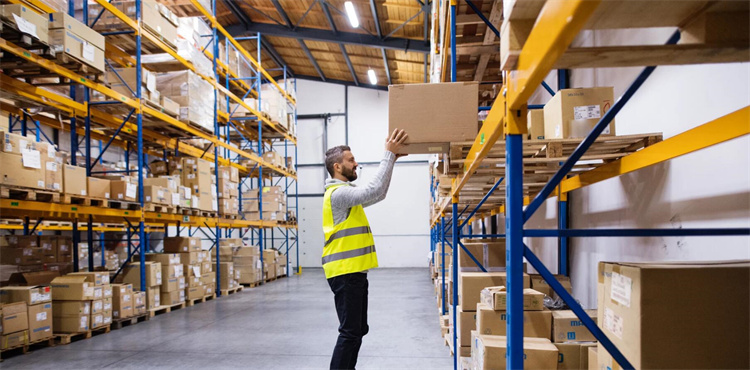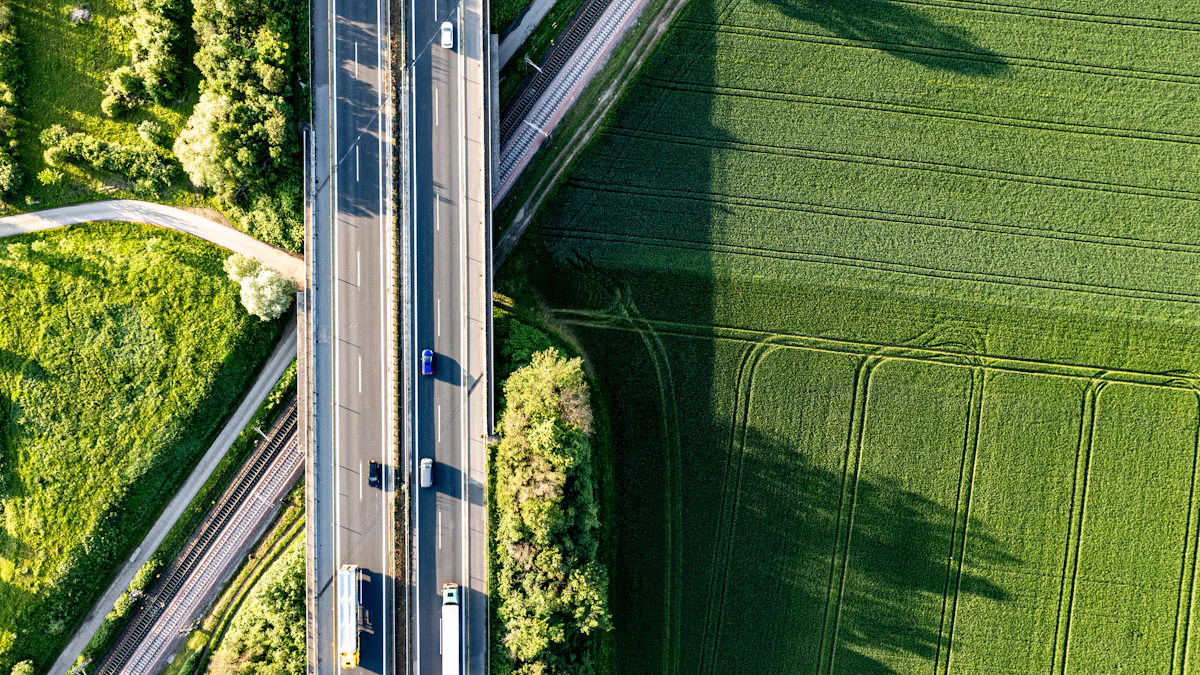Green Logistics Trends Shaping Industry Sustainability in 2025

You hold the power to transform the planet through green logistics. By 2025, innovation will redefine sustainability. Companies are already making strides: 85% have waste reduction programs, and 60% invest in green material handling. With cleaner fuels, AI-driven efficiency, and eco-friendly packaging, the logistics industry is reshaping the future.
Key Takeaways
Use electric or alternative fuel vehicles to cut pollution and costs.
Apply AI and IoT tools to improve supply chains and work faster.
Create clear eco-friendly goals and check progress often to stay responsible.
The Current Landscape of Green Logistics and Sustainability
Regulatory pressures shaping sustainable logistics practices
You are witnessing a global shift in how regulations are driving sustainable logistics. Governments and organizations are setting ambitious goals to combat climate change. For instance, companies in the EU must reduce carbon emissions by 55% by 2030 compared to 1990 levels. This pushes logistics providers to adopt greener practices. Carbon pricing, projected to reach $50-$100 per ton by 2030, further incentivizes eco-friendly operations by penalizing non-compliance.
Programs like SmartWay encourage freight carriers to improve fuel efficiency and reduce emissions. Meanwhile, initiatives such as the Net-Zero Emissions Target by 2050 are reshaping the logistics landscape. These efforts promote cleaner transportation systems and modernized infrastructure, including EV chargers. As a result, the environmentally friendly logistics services market is projected to grow by nearly 8% by 2033. You can see how these regulations are not just mandates but opportunities to innovate and lead in sustainable logistics.
Growing consumer demand for eco-friendly supply chains
Consumers like you are demanding more sustainable choices. A NielsenIQ study reveals that 78% of US consumers value a sustainable lifestyle. This preference is reshaping supply chains. Companies are prioritizing recyclable packaging and sourcing from environmentally responsible suppliers. Waste reduction and recycling are now top concerns, rated 3.8 times higher than climate change issues.
Businesses are responding. For example, PepsiCo has reduced greenhouse gas emissions by 26% since 2015 by aligning with consumer expectations. These shifts show how your choices influence corporate strategies, driving the adoption of sustainable logistics solutions.
Environmental challenges and the logistics sector’s carbon footprint
The logistics sector faces significant environmental challenges. Transport emissions account for approximately 24% of global energy-related CO2 emissions. Fossil fuel-powered vehicles dominate the industry, contributing heavily to carbon emissions. Refrigeration and other logistics operations consume large amounts of energy, often sourced from non-renewable resources.
Packaging demands lead to deforestation, while excessive waste generation strains ecosystems. Water pollution from hazardous material handling and noise pollution from transportation further impact communities and wildlife. With logistics contributing around 60% of global emissions, you can see why transforming this sector is critical for sustainability.
Emerging Green Logistics Trends for 2025

Electric and alternative fuel vehicles revolutionizing transportation
You are witnessing a revolution in green transportation. Electric and alternative fuel vehicles are transforming logistics by reducing carbon emissions and air pollution. Governments and companies are incentivizing this shift with initiatives like the Infrastructure Investment and Jobs Act, which allocates $7.5 billion for EV chargers and $39 billion for modernizing public transit. Tax credits, such as the Alternative Fuel Infrastructure Tax Credit, offer businesses up to $30,000 for installing fueling equipment for alternative fuels like hydrogen. These measures make it easier for you to embrace sustainable practices in transportation.
AI and IoT driving supply chain efficiency
AI and IoT are reshaping logistics with smarter, greener solutions. AI optimizes processes like demand forecasting and inventory management, ensuring real-time stock adjustments. IoT devices provide visibility into every stage of the supply chain, enabling you to make informed decisions. Companies like Amazon and Ocado use these technologies to enhance order fulfillment and reduce energy consumption. Smart sensors and GPS tracking improve vehicle performance, while predictive maintenance minimizes downtime. These innovations make green transportation more efficient and sustainable.
Green shipping options and carbon-neutral delivery innovations
Eco-friendly deliveries are becoming the norm. Shipping companies are adopting electric delivery vehicles and optimizing routes to cut emissions. Innovations like e-methanol and ammonia fuels are gaining traction. Maersk’s dual-fuel vessel, powered by green methanol, showcases the potential of these technologies. Sustainable packaging and energy-efficient warehouses further reduce environmental impact. By measuring emissions and investing in carbon offset projects, you can achieve carbon neutrality in your shipping operations.
Circular supply chains for waste reduction and resource optimization
Circular supply chains are redefining sustainability. By reusing materials and minimizing waste, you can lower carbon emissions and reduce your ecological footprint. This approach supports global efforts to combat climate change. Companies are embracing circular models to optimize resources and create a more sustainable future.
Renewable energy adoption in logistics infrastructure
Renewable energy is powering the future of logistics. Solar panels on rooftops and wind farms in open spaces are reducing energy costs and carbon footprints. Governments are offering subsidies to encourage the adoption of renewable energy. By integrating solar, wind, and biofuels into logistics infrastructure, you can stabilize energy costs and enhance your brand’s reputation. This shift ensures a sustainable and profitable future for green transportation.
How JUSDA is Leading the Way in Green Logistics
JUSDA ESG: Driving sustainability through integrated supply chain solutions
You can rely on JUSDA to lead the charge in green logistics. Through its ESG initiatives, JUSDA integrates sustainability into every aspect of supply chain management. The company’s solutions cover the entire process, from raw material procurement to final delivery. By adopting advanced technologies like IoT and big data, JUSDA ensures efficient operations while reducing environmental impact. Its global network of over 155 service points and 2.5 million square meters of warehousing space supports seamless transportation and logistics.
JUSDA’s commitment to sustainability goes beyond reducing carbon emissions. It promotes energy-efficient practices and green office initiatives. These efforts align with global goals to combat climate change and create a more sustainable future for the logistics industry.
Leveraging JusLink for real-time supply chain collaboration
JusLink transforms how you manage transportation and logistics. This intelligent platform uses IoT, cloud computing, and big data to provide real-time visibility across the supply chain. You can track shipments, optimize routes, and reduce delays with ease. JusLink also enables predictive analytics, helping you make informed decisions and minimize waste.
By enhancing collaboration between suppliers, manufacturers, and customers, JusLink ensures smoother operations. Its ability to integrate with existing systems makes it a valuable tool for businesses aiming to embrace green logistics and improve efficiency.
Industry-specific solutions for sustainable logistics
JUSDA tailors its solutions to meet the unique needs of various industries. Whether you operate in electronics, automotive, or FMCG, JUSDA offers customized strategies to optimize transportation and logistics. For example, its collaboration with Sharp reduced logistics costs by 20% while improving order processing cycles.
These industry-specific solutions focus on reducing waste, improving energy efficiency, and adopting renewable energy sources. JUSDA’s expertise ensures that your business can achieve its sustainability goals while maintaining operational excellence.
Adapting to Green Logistics Trends: A Guide for Businesses

Modernizing fleets with electric and alternative energy vehicles
You can modernize your fleet by transitioning to electric and alternative energy vehicles. This shift reduces operating costs and helps you meet sustainability targets. Electric vehicles (EVs) require fewer fluids and parts, lowering maintenance expenses. To get started:
Plan the charging infrastructure for your fleet.
Assess the infrastructure needed to support EVs.
While the initial investment may seem high, the long-term savings and environmental benefits outweigh the costs. Challenges like range anxiety and managing charging schedules can be addressed with proper planning and technology. By embracing EVs, you contribute to a cleaner future in transportation.
Upgrading infrastructure for sustainable operations
Upgrading your logistics infrastructure is essential for sustainable operations. Modernize your fleet with IoT sensors and advanced software to improve efficiency. Integrate IT systems and telematics for operational consistency. Use analytics tools to track progress and optimize logistics networks.
Companies like Amazon are leading the way by investing in renewable energy projects. You can follow their example by installing solar panels or adopting hydrogen fuel technologies. These upgrades not only reduce emissions but also enhance your brand’s reputation.
Using data and technology for logistics optimization
Data and technology are your allies in achieving green logistics. Use route optimization tools to reduce mileage and fuel consumption. Predictive maintenance ensures your vehicles operate efficiently. Demand forecasting helps you adjust fleet size and balance loads effectively.
Platforms like Tableau and SAP SCM provide insights into your supply chain, enabling better decision-making. By leveraging these tools, you can minimize your environmental footprint and cut costs simultaneously.
Setting and tracking measurable sustainability goals
Setting clear sustainability goals is crucial for accountability. Start by assessing your carbon emissions to establish a baseline. Use this data to set reduction targets and develop action plans. Regularly monitor and report your progress to stakeholders.
Conduct sustainability audits to identify problem areas. Implement structured frameworks to drive continuous improvement. Transparent reporting builds trust and ensures adherence to ecological standards.
Partnering with green logistics experts like JUSDA
Partnering with green logistics experts simplifies your journey toward sustainability. JUSDA offers tailored solutions that integrate advanced technologies like IoT and big data. Their expertise ensures compliance with environmental regulations and enhances operational efficiency.
By collaborating with JUSDA, you gain access to innovative tools and strategies that align with your sustainability goals. This partnership not only reduces your carbon footprint but also strengthens your brand image, attracting environmentally conscious customers.

JUSDA Solutions
To provide you with professional solutions and quotations.
Green logistics holds the key to a sustainable future. By embracing innovation, you can transform your operations and reduce environmental impact. Businesses looking to lead in 2025 should focus on:
Shifting to alternative fuels like electricity and hydrogen.
Optimizing supply chains with AI and big data.
Adopting green warehousing with energy-efficient systems.
Using eco-friendly packaging to minimize waste.
Investing in carbon offsetting programs to balance emissions.
Collaboration with industry leaders amplifies these efforts. Partnerships in transportation, warehousing, and retail drive impactful change. Initiatives like the SmartWay Transport Partnership have already saved billions and reduced emissions significantly. Urban consolidation centers using electric vehicles showcase the potential of collective action.
Your commitment to sustainability not only benefits the planet but also strengthens your brand. Partner with innovators like JUSDA to achieve your goals and lead the way in green logistics.
See Also
Key Trends Shaping Future Efficiency In Supply Chains
Innovative Robotics Trends Enhancing Sustainability In Supply Chains
Comprehensive Insights On Sustainable Transportation For Supply Chains
Revealing JUSDA's Growth In Sustainable Logistics Efficiency
